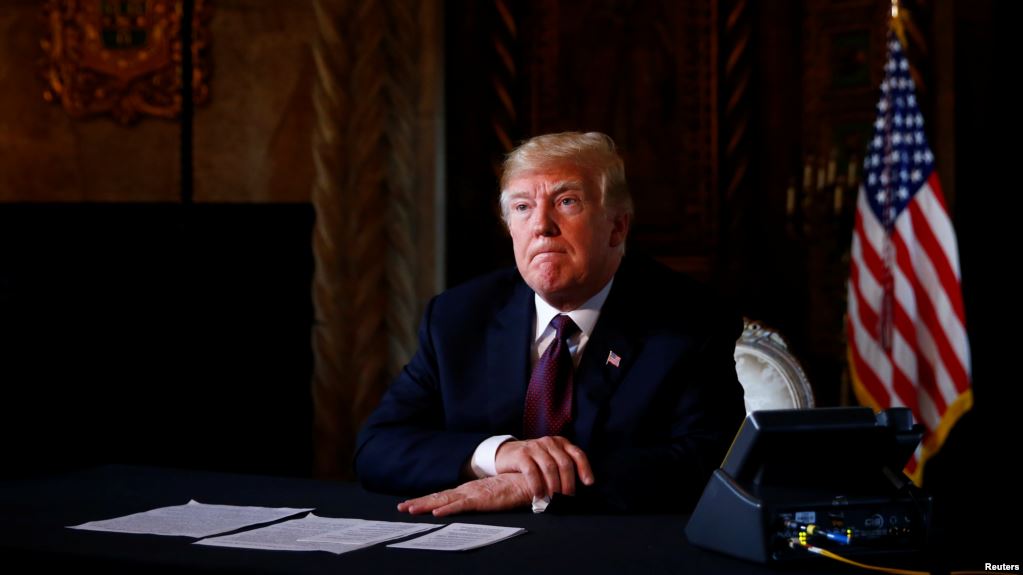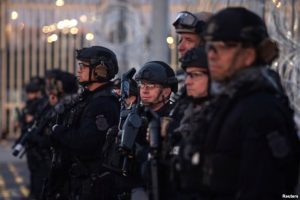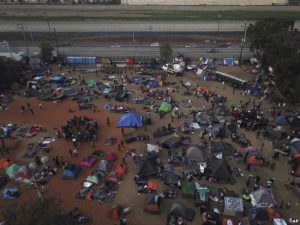
U.S. President Donald Trump takes questions from the media after speaking via teleconference with troops from Mar-a-Lago estate in Palm Beach, Florida, Nov. 22, 2018.
U.S. President Donald Trump threatened Thursday to shut down the U.S.-Mexican border, disrupting a $1.68 billion-a-day trading relationship.
By Aline Barros and Jeff Seldin / 11.22.2018
U.S. President Donald Trump threatened Thursday to shut down the U.S.-Mexican border, disrupting a $1.68 billion-a-day trading relationship, if his government cannot control the flow of undocumented migrants seeking to cross into the United States from Latin America.
Trump was speaking to reporters at his Mar-a-Lago resort in Florida, where he is spending the Thanksgiving holiday. He also reaffirmed Defense Secretary Jim Mattis’s remarks Wednesday that U.S. troops at the Mexican border have been authorized to use lethal force if necessary to defend Border Patrol agents from would-be border crossers.
U.S. Customs and Border Protection (CBP) Special Response Team (SRT) officers stand guard at the San Ysidro Port of Entry after the land border crossing was temporarily closed to traffic from Tijuana, Mexico, Nov. 19, 2018.
The remarks followed a televised holiday telephone call to U.S. troops serving in Asia and the Pacific, which came amid criticism that he has not visited front-line troops since becoming president.
Some 5,800 U.S. soldiers are spending Thursday’s Thanksgiving holiday stringing barbed wire and building tent camps at the Mexico border amid a growing controversy over possible violation of a 130-year-old U.S. law barring use of the military for domestic law enforcement activities.
Addressing concerns about a caravan of Central American migrants who have begun arriving at the border with Mexico with a goal of seeking asylum in the United States, Trump said his administration would “close entry into the country for a period of time” if the situation “gets to a level where we are going to lose control or where people are going to start getting hurt.”
“The whole border. I mean the whole border. Mexico will not be able to sell their cars into the United States where they make so many cars,” he added.
According to the office of the U.S. Trade Representative, U.S.-Mexico trade last year totaled an estimated $615.9 billion, or about $1.68 billion a day.
Secretary of State Mike Pompeo echoed the president, saying the migrants would not be allowed into the United States for their own safety.
.@SecPompeo: The caravans will not be permitted to enter the United States. There are real dangers to the safety and human rights of migrants from those who would prey on them. Read the full statement: https://t.co/2wQAnDWeAv
— Department of State (@StateDept) November 23, 2018
Trump also said the troops at the Mexico border have been authorized to use lethal force if necessary, reiterating remarks Wednesday by Mattis.
News reports had quoted the commander in charge of the mission as saying some of the troops could begin heading home as early as this week and that the operation in support of Border Patrol forces should be completed by mid-December. But rather than wind down the mission, the Trump administration appears to be stepping it up.
“The president did see a need to back up the Border Patrol [officers], and we received late last night an additional instruction authorizing us to implement additional measures. We’re sizing up what those are,” Defense Secretary Jim Mattis told reporters.
Legal experts say the order could run afoul of the 1878 Posse Comitatus Act, which together with an even earlier act, limits the federal government’s power to use military personnel to enforce domestic policies.
U.S. Border agents and the Coast Guard patrol the Pacific Ocean where the U.S. Mexico border wall enters the water at Border Field State Park in San Diego, California, Nov. 20, 2018.
The escalation stems from a White House memo issued Tuesday authorizing the military to take measures it considers “reasonably necessary” to protect federal personnel at the border. This could include “a show or use of force (including lethal force, where necessary), crowd control, temporary detention, and cursory search,” the memo said.
In speaking to reporters, however, Mattis downplayed the likelihood of lethal force being used.
“I think part of this is just putting in the crowd control barriers and the barbed wire. If there’s one thing you don’t want to walk through, any of us as human beings, it’s barbed wire. Even cows are smart enough to stay away from that stuff,” he said. He pointed out that although military police would have shields and batons, most of the troops at the border are not armed.
The troops were initially deployed to the border in the midst of a heated congressional election campaign following reports that a caravan of Central American migrants was headed for the border to seek asylum in the United States.
President Donald Trump ordered the forces to be in position to back up the Border Patrol agents in the event they were overwhelmed. Critics derided the move as a political stunt to stir passions ahead of the election, and while some of the migrants recently reached the border, there have been no violent incidents.
Members of the U.S. military install multiple tiers of concertina wire along the banks of the Rio Grande near the Juarez-Lincoln Bridge at the U.S.-Mexico border, Nov. 16, 2018, in Laredo, Texas.
Soldiers told a VOA reporter at the border this week that they have been engaged mainly in stringing barbed wire along border crossing points and building tent camps for themselves.
In an email to VOA, Hina Shamsi, director of the American Civil Liberties Union’s National Security Project, said the Cabinet order was an “unnecessary escalation of a political stunt that risks harm to civilians and legal jeopardy for the military.”
Shamsi cited “serious concerns” about violation of the Posse Comitatus Act and questioned the authority of White House Chief of Staff John Kelly, who issued the memo, to give the military such an order.
Central American migrants gather at a temporary shelter, near barriers that separate Mexico and the United States, in Tijuana, Mexico, Nov. 21, 2018.
While none of the soldiers at the border will be spending the Thanksgiving holiday with their families, Mattis told reporters at least some of them could “certainly” be home before Christmas, another major family gathering time for Americans.
“So as long as [Department of Homeland Security] doesn’t assign us more missions to lay more wire, which they could, then we could anticipate they’d be home,” he said. “I would anticipate they would be, but some troops may not be, or some new troops may be assigned to new missions. This is a dynamic situation.”
Originally published by Voice of America under a Government Public Domain license.







